
Redfish is a common name for several species of fish. It is most commonly applied to certain deep-sea rockfish in the genus Sebastes, red drum from the genus Sciaenops or the reef dwelling snappers in the genus Lutjanus. It is also applied to the slimeheads or roughies, and the alfonsinos (Berycidae).

The Beryciformes are a poorly-understood order of carnivorous ray-finned fishes consisting of 7 families, 30 genera, and 161 species. They feed on small fish and invertebrates. Beyond this, little is known about the biology of most member species because of their nocturnal habits and deepwater habitats. All beryciform species are marine and most live in tropical to temperate, deepwater environments. Most live on the continental shelf and continental slope, with some species being found as deep as 2,000 m (6,600 ft). Some species move closer to the surface at night, while others live entirely in shallow water and are nocturnal, hiding in rock crevices and caves during the day. Several species are mesopelagic and bathypelagic. Beryciformes' bodies are deep and mildly compressed, typically with large eyes that help them see in darker waters. Colors range from red to yellow and brown to black, and sizes range from 8–61 cm (3.1–24.0 in). Member genera include the alfonsinos, squirrelfishes, flashlight fishes, fangtooth fishes, spinyfins, pineconefishes, redfishes, roughies, and slimeheads. A number of member species are caught commercially, including the alfonsino, the splendid alfonsino, and the orange roughy, the latter being much more economically important. Some species have bioluminescent bacteria contained in pockets of skin or in light organs near the eyes, including the anomalopids and monocentrids.

The beardfishes consist of a single extant genus, Polymixia, of deep-sea marine ray-finned fish named for their pair of long hyoid barbels. They are classified in their own order Polymixiiformes. But as Nelson says, "few groups have been shifted back and forth as frequently as this one, and they were recently added to Paracanthoptergii". For instance, they have previously been classified as belonging to the Beryciformes. They are of little economic importance.
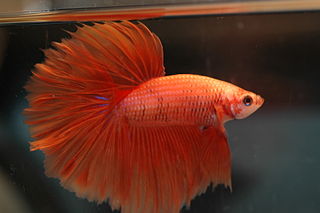
The Siamese fighting fish, commonly known as the betta, is a freshwater fish native to Southeast Asia, namely Cambodia, Laos, Myanmar, Malaysia, Indonesia, Thailand, and Vietnam. It is one of 73 species of the genus Betta, but the only one eponymously called "betta", owing to its global popularity as a pet; Betta splendens are among the most popular aquarium fish in the world, due to their diverse and colorful morphology and relatively low maintenance.

The alfonsino, also known as the alfonsin, longfinned beryx, red bream, or imperador, is a species of deepwater berycid fish of the order Beryciformes. It can be found in temperate and subtropical ocean waters nearly worldwide, though it is uncommon. It is typically associated with deep-sea corals, and schools are known to form over seamounts. Adults are demersal and search for prey along the ocean floor, primarily fish, cephalopods, and crustaceans. Like other members of its family, it is remarkably long-lived, with individuals reaching ages of up to 69 years, and possibly longer. It can reach sizes of up to 1 m (3.3 ft) in length and 2.5 kg (5.5 lb) in weight and is targeted by commercial fisheries. Its low reproductive rate and the time it takes for juveniles to mature make it vulnerable to expanding deep-sea fisheries, but it is listed as Least Concern by the International Union for Conservation of Nature (IUCN) due to its extensive range.
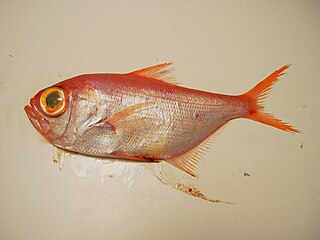
The splendid alfonsino is an alfonsino of the genus Beryx, found around the world at depths between 25 and 1,250 metres, usually between 400 and 600 metres. Although its most common size is 40 centimetres (16 in), it can reach lengths of up to 70 centimetres (28 in). It is known as kinmedai (金目鯛) or "golden eye snapper" in sushi and Japanese cuisine.

The Miami Terrace Reef is a coral reef off the coast of Florida stretching from South Miami to Boca Raton, in the Atlantic Ocean. It lies in depths of 650 to 2,000 feet on top of a geological formation known as the Miami Terrace, a 40-mile (65 km) long shelf about 15 miles (24 km) off shore. Much of the platform remains unexplored, and new portions of the reef are still being discovered. University of Miami researchers discovered new reef sites there in December 2005.
The South East Atlantic Fisheries Organisation (SEAFO) is an organization that maintains controls over fishing and fishing related acts in the Southeastern Atlantic Ocean.
Palometa is a name used for several species of fish:

Centroberyx, often referred to as nannygais, is genus of ray-finned fishes found in the Indian Ocean and western Pacific Ocean, with the greatest species richness off southern Australia. They are reddish in colour and somewhat resemble the related soldierfish. Depending on species, they have a maximum length of 20 to 66 centimetres. They are found at depths of 10 to 500 metres. Members of this genus are also known from fossils from the Cretaceous.

Berycidae is a small family of deep-sea fishes, related to the squirrelfishes. The family includes the alfonsinos and the nannygais.

Fouquieria is a genus of 11 species of desert plants, the sole genus in the family Fouquieriaceae. The genus includes the ocotillo and the Boojum tree or cirio. They have semisucculent stems with thinner spikes projecting from them, with leaves on the bases spikes. They are unrelated to cacti and do not look much like them; their stems are proportionately thinner than cactus stems and their leaves are larger.

Betta is a large genus of small, active, often colorful, freshwater ray-finned fishes, in the gourami family (Osphronemidae). The best known Betta species is B. splendens, commonly known as the Siamese fighting fish and often kept as an aquarium pet.

Echinus tylodes is a species of sea urchin in the Echinidae family. It is white with rather sparse pink spines, and is endemic to the eastern coast of North America including the Gulf of Mexico.
B. splendens may refer to:
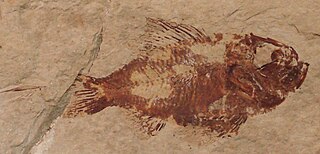
Ctenothrissiformes is an extinct order of prehistoric ray-finned fish.
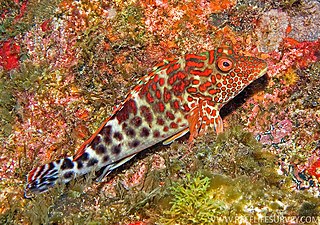
The splendid hawkfish, also known as mottled hawkfish, is a species of marine ray-finned fish, a hawkfish belonging to the family Cirrhitidae. It is found on tropical reefs of the Pacific Ocean.
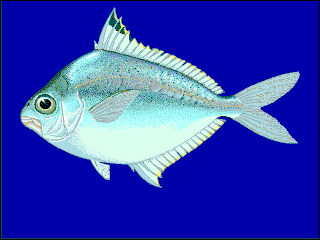
Eubleekeria splendens, common names splendid ponyfish and blacktip ponyfish, is a species of ponyfish.

Listriodon is an extinct genus of pig-like animals that lived in Eurasia during the Miocene.

Novodinia antillensis, the velcro sea star, is a species of starfish in the family Brisingidae. It is found in the deep sea in the tropical and subtropical western Atlantic Ocean, being quite common at a depth of around 500 m (1,640 ft) on the Mesoamerican Reef off Roatán, Honduras.














